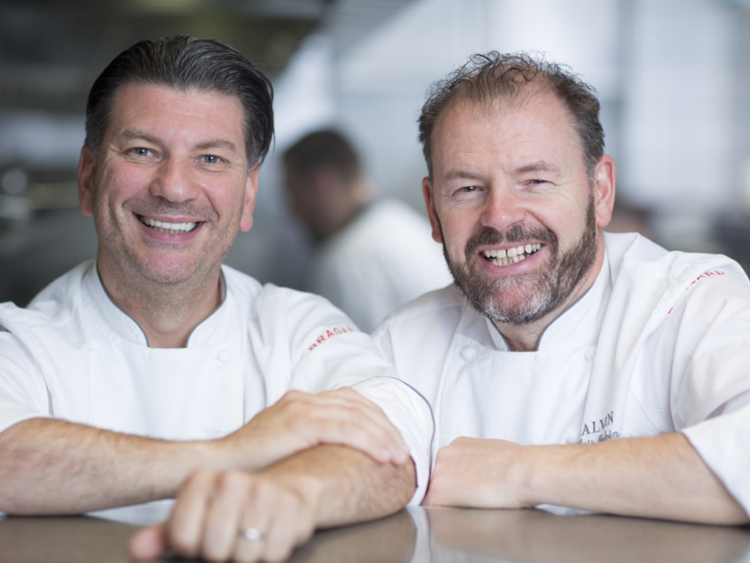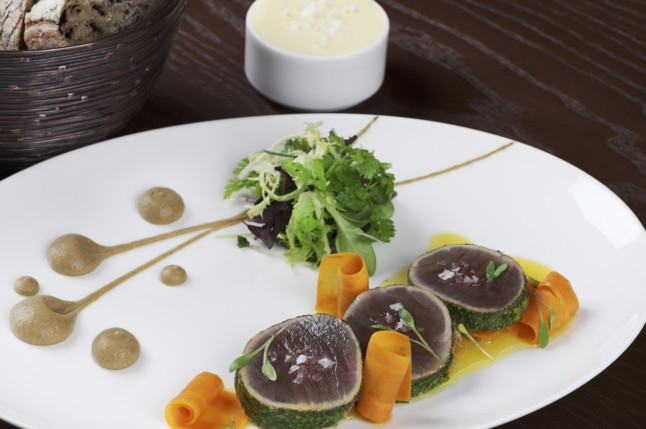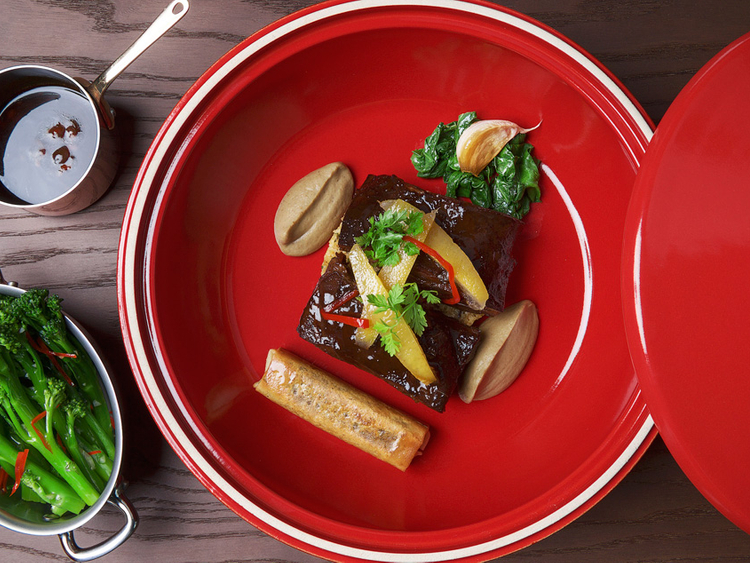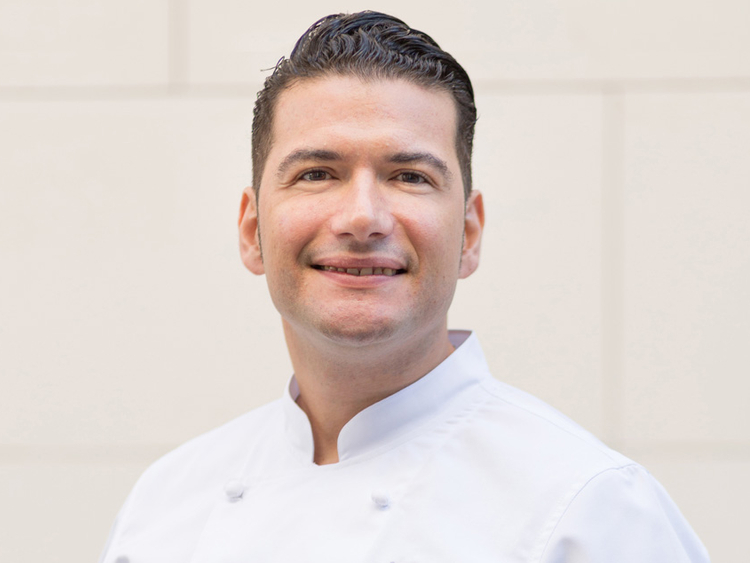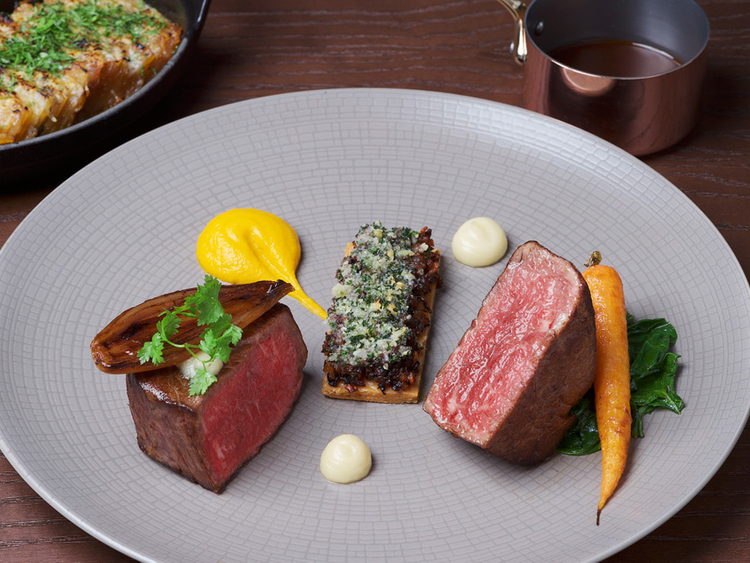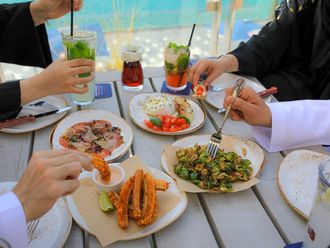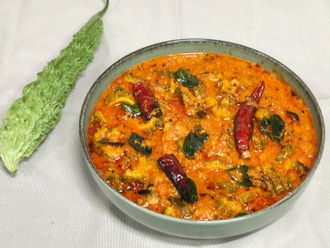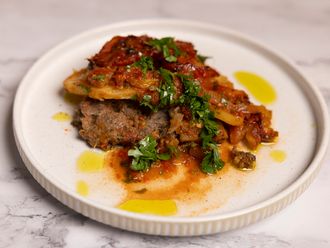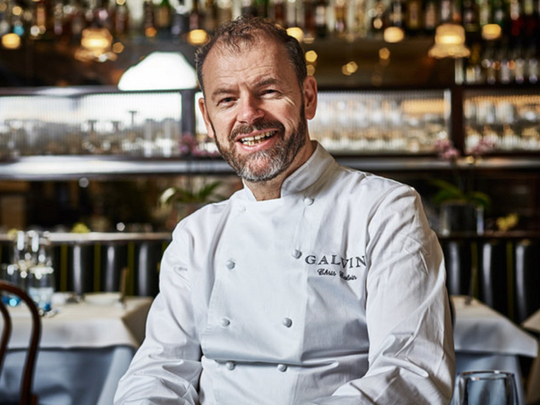
For a dreamer, which is how Chris Galvin refers to himself, he’s done rather well. The 59-year-old Essex native, who had a poster of Paul Bocuse on his wall as a boy, began his culinary career as a pot washer at the age of 15. But he’s managed to stand the heat, and with his brother Jeff, also a chef who began as a pot washer, they serve an estimated 25,000 guests a month across 12 restaurants in the UK and the UAE, including two Michelin-starred establishments in London.
Galvin Dubai, with a warm Mediterranean-inflected menu, is their latest venture, having opened at City Walk last month. From rags to riches, Chris Galvin’s is an inspiring story — as he recounted on a humid afternoon in Dubai. In his own words:
My father disappeared when I was 15.
So we never had any money, though I’d never say I come from nothing, because I did come from something — a good mum, a good family. You’re wealthy when you’ve got family. But I had to get a job because we were desperate. We had our clothes and things, but they were often second-hand — our first Christmas we had charity presents. It’s horrible at that age, you wanna look cool with the rest of the guys. It’s still with me.
I learnt cooking in high school.
“I’ve always loved cooking — we learnt in high school. They’ve stopped now, which is a disaster. Thankfully Jamie Oliver is pushing to bring it back, because we have huge big health problems now. Many people are grossly overweight. I was lucky cooking was compulsory — and because my Nan had a war garden when everyone was encouraged to grow as much as they could. That was where I got my start.
I used to knock on restaurant doors to try and get a job.
Thank god for a chef called Antony Worrall Thompson, who was the number two chef at a neighbourhood restaurant, where I got a job washing lettuces, doing prep like everyone does. This is before Antony became a celebrity, he was Lady Diana’s favourite chef you know. But the kitchen gave me an instant family. Kitchen. Warmth. Food. Money. Everything. I couldn’t want for more. I was just so lucky.
We got in a terrible mess when we changed the plating.
It was 1975, and nouvelle cuisine was just coming in. At the time, the chef had to put all the food on the silver and a waiter dressed it at the table. And Anthony said to me, there’s this guy in France who’s putting the food on a plate. So we waited until the old chef, who was from the Savoy, got a night off, and then put the food on the plate. We got in all sorts of trouble! And then I went to the Ritz and did an apprenticeship with Michael Quinn, which I loved, and then to Inigo Jones.
We had an English food revolution at the Ritz.
I was lucky to be there with the first-ever English head chef, Michael Quinn. It was groundbreaking because at the time menus were always in French with an English description underneath — it was always wrong! And the customers were totally intimidated — by the menu, by the waiter, by the food. The arrogance towards customers was shocking. There was a barrier at the table — and also in the kitchen. Then Michael Quinn said, we’re English, we’ve got English ingredients, so he threw the lot out and did the menus in English. I was lucky I was there then because we’d had a ceiling, where we could never break through. The sous chefs were always French.
I really learnt a lot about food in New York.
A few years later, I met up with Anthony again. He was running his own restaurants now, he had Ménage a Trois in Beauchamp Place in Knightsbridge, and also one in Bombay. And one in New York, where I went as Head Chef in 1986. It blew my mind. I loved New York. You got to New York and you realise London is a tiny backwater village. And the ingredients! That’s what shocked me, they were amazing. Coming from London, I just thought they had burgers. But they didn’t just have foie gras, there were three grades. The level of quality was unbelievable. And the diversity. There was Italian food, Chinese, and all the ingredients were grown in the countryside in uptown New York.
I learnt management as a 25-year-old running a kitchen.
I had a face of a baby and I had to tell all these big guys what do to! But what I had going for me was that I was a good cook. The first thing I did was enforce discipline. When I got to the restaurant, people were late, they were lazy. So I sat them down the first week and said, right — if you don’t want to come in on time and stay till the job is done, you can walk out now. I remember thinking, if they go I’m in big trouble. But they stayed on thankfully.
As a stranger, bars can be your friend.
But working in New York, I couldn’t make friends with any of the staff or I’d lose everything I’d enforced. There’s got to be a line you don’t cross. So I’d go to a bar — I’m not a big drinker, but I’d always be welcomed, and immediately fixed a drink. And then you’d meet people in the bar, and get talking and make friends. So I really love bars. I love eating in bars a lot. I think you get to understand a tapestry of a city. Dining at bars is a big thing for me now. That’s what we want to do here, at the upstairs bar at Galvin Dubai.
I was in my 40s when I decided to go into business.
My brother Jeff — he’s the dreamer and I’m the doer — and I decided to launch on our own while I was at the Wolsley. I’d spent 10 years working with Terence Conran, who was groundbreaking — he always said people don’t know what they want until you give it to them, and I learnt all about French produce from him. [With Galvin at its helm, the Orrery won a Michelin star in 2000]. Then I got to work with Chris Corbin and Jeremy King and they opened the Wolseley. They were very front-of-house driven, very intense — if they were buying new chairs, they’d sit down and stand up in them a hundred times! So that was kind of a finishing school. We were going to do lots more together... but then one day I thought, I’ve got to do it myself. I’ll never forget — I looked in the mirror, and said, It’s you mate, you’ve got to do it. And if it goes wrong, you can’t blame anyone else.
You’ve got to give it your all.
So I rang Jeff who was working for Marco Pierre White. I said Jeff I think I’ve got to do a restaurant. That was our dream as kids. Jeff was three years old when I was 15, so I was more his dad. And once you go in the kitchen, you don’t really see anyone. So working together was a way to really be together. Our middle bother also joined us to do markets. So we started looking at the back of the Caterer magazine for cheap sites, but we were so naive about financials. We were ready to go with a nice chap who said we didn’t have to put up much money, just launch and run the show. And I showed the business plan to one of our customers in venture capital. He went, ‘Oh my God. See this — you’ve got to pay for their aborted opening costs after year five. You have to pay for their mistakes.’ He saved us at the end, but that’s when I realised I had to be more invested.
Running our own restaurant didn’t feel any different.
We put our own money in and borrowed more to the Baker Street bistro off the ground. Alan Yau had just closed a restaurant there, so you had this amazing site, but everyone was going, if it did work for the great Alan Yau, why’s it going to work for you? I remember picking the keys up, and we ran like two children down the street to the restaurant! It was ours. But interestingly, after three months I looked at my brother as we were cooking one night and said, ‘Jeff, do you feel any different?’ And he said no. I put it down to the fact that we’ve always owned other people’s business. Always protected other people’s money. And I still feel we are owned by someone. Probably the bank.
It took us 10 years to find a business partner in Dubai.
We kept coming to look for the right partner; we’ve been everywhere — especially my brother Jeff. It’s never been about the money, we wanted to needed to find someone we felt we could trust, who believed in us, and who made the trip to visit us in London. I’ve got a shelf at work with all the concepts we’ve said no to. So we like Meraas because they took the time to understand our DNA. Because I’ve got a feeling Dubai will be very important to us, even though there are so many restaurants here. But what we’d like to do here is grow the local scene, which is why Luigi Vespero is executive chef here. There’s so much latent talent now that needs to be encouraged. These young people are the pillars of home-grown cuisine, and they need to be nurtured. Like I was, I had that and I’d like to give back."
—————
Food of the sun: A taste of Galvin Dubai
The flavours of the Mediterranean underpin the British fare at Galvin Dubai, the third restaurant at The Square, the licensed hideaway at the heart of City Walk Dubai.
It is the first restaurant from the brothers Chris and Jeff Galvin in Dubai after their Demoiselle by Galvin cafe opened earlier this year, a few metres away within the same complex.
But everything on the menu at the two-level 120-seater, says Chris Galvin, who has franchised the restaurant to mall operator Meraas, has been designed especially for diners in Dubai, and is helmed by Luigi Vespero, a Galvin alumnus who will be familiar to many for a stint at the Rib Room at Emirates Towers, and who’s brought his own touch to the menu with ingredients such as tomatoes from Vesuvius.
“It’s about cooking to your location,” Galvin says of the food. “As I stepped off the plane, from cool and wet London, where right now it’s about deep cooking, braises — you come here and immediately you’re thinking much lighter cooking, straight away I started to think of Cote d’Azur.”
He nods straightaway to Roger Vergé, whose light, healthy recipes were in many ways a precursor to the modern fad for clean eating. “So we thought ‘food of the sun’. That’s what we’re doing here,” he says. “Everything is bespoke, created for Dubai.”
What does that translate to on the plate? Comfort food with bags of flavour — just the sort of meal you want a hit of again and again, as I discovered on a tasting (that they have their own brand of bubbles at very competitive prices doesn’t hurt). The steak tartare was a particular winner, with notes of sweet tomato relish beautifully rounded out by creamy egg yolk confit. It’s the sweetest tartare I’ve ever eaten, but that’s no bad thing. A tuna escabeche, delicately marinated yellowfin, came with a creamy aubergine dip and caramelised carrots didn’t match up, but Vespero’s own Garden on ice will find favour with tapas lovers. The cold platter features a delectable hummus (I wanted just a smidgen more olive oil), a zesty truffle aioli with a gentle garlic underlayer, and a moreish olive tapenade.
I’d also recommend the roasted seabass, which sits on a bed of velvety cauliflower purée and is topped with capers and raisins. Crisp but flaky, this is a dish that will transport you straight to the Mediterranean. A mildly underseasoned tenderloin was lifted by a rich bone marrow tart and caramelised shallots, and a bright, peppery jus.
The tarte tatin, made with meaty pink lady apples, didn’t wow us, nor did the classic Baba au Rhum — although it was lovely to see retro, familiar desserts. As a gluten-free fiend, I was thrilled with the warm and runny chocolate fondant (yes there was ice-cream!) and a creme brulee topped with soaked fruits which is custardy and slightly creamy with no hint of egg but has a wafer for extra crunch.
We’ve just come off what seems like the hottest summer in recent memory, but Galvin Dubai will leave you with a new appreciation for the sun.
—————
Recipe: Tagine of lamb shank, couscous, confit lemon & harissa sauce recipe
Ingredients
For couscous
• Chicken stock 160g
• Couscous 170g
• Butter 30g
• Onion white 100g
• Red bell pepper 50g
• Vinegar 30ml
• Golden raisins 40g
• Parsley flat 25g
• Coriander 80g
• Mint 30g
• Piquillo peppers 80g
• Flaked almonds 70g
• Saffron 0.2g
For Braised lamb
Carrot 500g
onion 500g
Celery 250g
Leek 250g
Garlic peeled 35g
Cinnamon 10g
Ginger 30g
Cumin 10g
Allspice 10g
Cardamom 10g
Coriander seed 10g
Chicken stock 5kg
Lamb shank 2kg
Verjuice 500ml
Aubergine puree 40g
Pastille same recipe as foie gras
Confit lemon
METHOD
Braised lamb
Brown the lamb in a heavy bottom saucepan in a little oil, remove the lamb, then brown the roughly chopped vegetables and garlic in the same pan.
Add the spices to the pan and cook gently for a few minutes, being careful not to burn.
Add the lamb and all other ingredients and bring to the boil, skim and cover with a lid.
Cook in the oven for 2 ½ hours at 110 degrees C.
Allow to cool in verjuice.
Remove the lamb carefully, then pass the liquid through a fine sieve or muslin cloth.
Reduce the liquid by half and finish with a little harissa to taste and this is the sauce.
Couscous
Bring the stock, oil, salt and pepper to the boil in a saucepan. Remove from the heat. Add the couscous to the hot liquid. Cover with a lid. Leave to swell for 5-10 minutes. Incorporate all of the remaining ingredients. Season to taste and stir briefly, so that the butter melts. Remove the lamb from the bone. Reheat the lamb in a little of the verjuice, reducing until the lamb is nicely glazed and shiny. Mix the lamb through the hot couscous, serve with some courgettes, carrots and wild rocket and drizzle with olive oil.
Aubergine puree
Cut aubergine in half score colour. Put thyme garlic on top bake in the oven at 180 degrees Celsius for 30 minutes. Scoop out blitz with cumin seeds add crème fraiche season pass.
Pastilla
In a medium bowl, combine the figs, dates, almonds, honey, vanilla and salt. Stir in the hot water. Cover with plastic wrap and let stand overnight. Preheat the oven to 400 degrees Celsius. Line a flat baking sheet with parchment paper. On a work surface, spread one sheet of phyllo dough with the long side facing you; brush with melted butter. Top with 3 more phyllo sheets, buttering each one. Spoon the filling along the bottom half of the phyllo dough and roll up the phyllo dough as tightly as possible, tucking in the ends as you roll.




